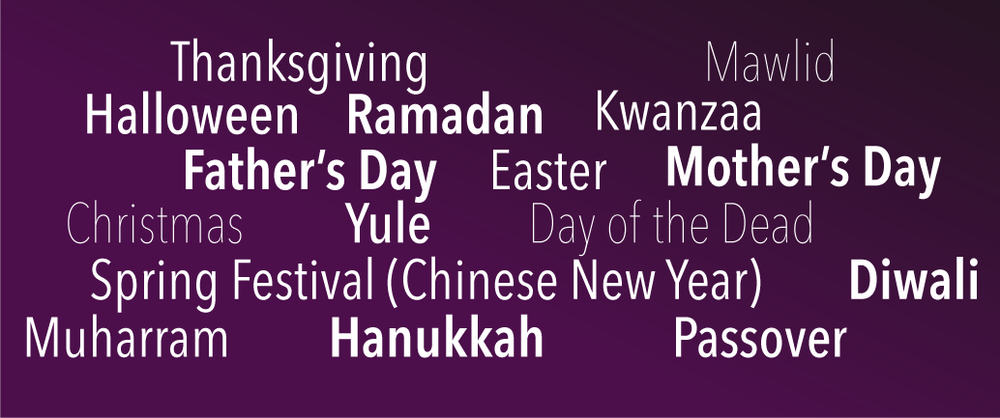Do you celebrate holidays in your early care or out-of-school program? What do holiday celebrations look like in your child care? The holidays present an opportunity for staff to offer engaging, developmentally appropriate, and culturally welcoming experiences for children and families.

Do any of the following descriptions of an approach to the holidays sound familiar?
"We've always done it this way"
Ms. Anita looks at the calendar and sighs. The fall and winter holidays are approaching. She gets her "holiday box" out of the closet and takes an inventory of what is available. There are black cats, ghosts, witches, and jack-o-lanterns for Halloween; pumpkins, turkeys, and pilgrims for Thanksgiving; and Christmas trees, ornaments, snowflakes, and Santa Clauses for Christmas. Ms. Anita smiles, knowing that she is ready for fall and winter holiday celebrations.
"Holiday tourists"
Mr. Jamal thinks that celebrating holidays is a great way to teach children about other cultures. The children in his group celebrate multiple holidays every month as they learn about holiday foods, dress, and traditions of families around the world.
"Celebrate meaningful holidays"
Ms. Tai spends a lot of time getting to know the children in her care and their families. She frequently talks with families to learn what holidays are celebrated in their homes. Holidays, which are important to the children and their families, are celebrated by asking families to come and share their holiday traditions with all the children in Ms. Tai's room.
"Celebrate shared days/seasons"
Mr. Frandsen enjoys celebrating with the children and their families, creating special opportunities to gather and enjoy one another's company and accomplishments. He plans events that follow the rhythm of his classroom program and the seasons in his province. Rather than celebrating religious holy days or national commemorative days, he and his diverse roster of children and families gather and enjoy the arrival of spring or the graduation of a class of children. Sometimes they create days to celebrate like "BIG" day or "Day of Dark."
"Holiday elimination"
Mr. Kadin knows that the children in his group represent many backgrounds, cultures, and religions. He decides that eliminating all holiday celebrations gives equal treatment to all children and avoids offending children and families. Holidays are reserved for home time.
When deciding a program strategy for holidays, staff should think carefully about the children's level of development, approaches to learning, and unconscious messages that might be communicated.
Before planning to celebrate a holiday, consider why children should learn about a particular holiday and whether the holiday is developmentally appropriate for young children. Meaningful holiday celebrations for children should be respectful of the values, wishes, and beliefs of all families in the group. Holiday activities should help children feel valued for who they are and what they do at home with their families. Children, not the holiday, should be the priority.
If a program decides to highlight a specific holiday, consider:
- Children under age eight have a limited sense of time. While adults may take weeks to prepare for a holiday event, this much anticipation and emphasis may be overwhelming and inappropriate for young children. A "normal" programming routine will be a comfort to children who are bombarded at other times with the commercial and stressful aspects of holidays. Limit observances to an afternoon or one day, if possible.
- If children are interested in insects, trucks, or building skyscrapers, why set aside those interests to inject a holiday event?
- If children celebrate holidays differently, use that information to increase a child's understanding of her friends and her diverse world. Children can still be friends and do things differently. One way is not better or more valued than another way.
- Emphasize celebration actions that don't cost money and that highlight learning and relationships. Include stories, songs, child-created art, discussions of "same" and "different," and family participation. Work with families so that as many children as possible can be included while respecting personal boundaries.
- Rather than assigning each child the task of creating a teacher-directed holiday craft, allow children to create with open-ended materials in response to a story, song, or play event. It is not necessary for a child to have something to take home for display/gifting.
- Ask questions like, "How will you celebrate ____________?" or "Will you do anything special with your family and friends for ________________?" rather than a question of "What do you want for ________?" Highlight relationships and de-emphasize commercial aspects of any holiday.
- Build discussions of and sharing about culture (same/different, interesting places in our world, "I'm curious" discussions) into daily and weekly lessons plans. Holidays should not be the only time children celebrate their identities as unique people.
Recognize that what seems normal and comfortable to people from the majority culture may be difficult for others. Santa bringing presents to the "good" children, evil costumes all in black, or pilgrims celebrating the good gifts from the land all create distance and discomfort for other people whose life experience is different.
As ECE professionals become more and more conscious of their own biases, they can have careful, informed conversations with colleagues and the families they serve to arrive at an appropriate approach to holidays, seasons, and program milestones together.

